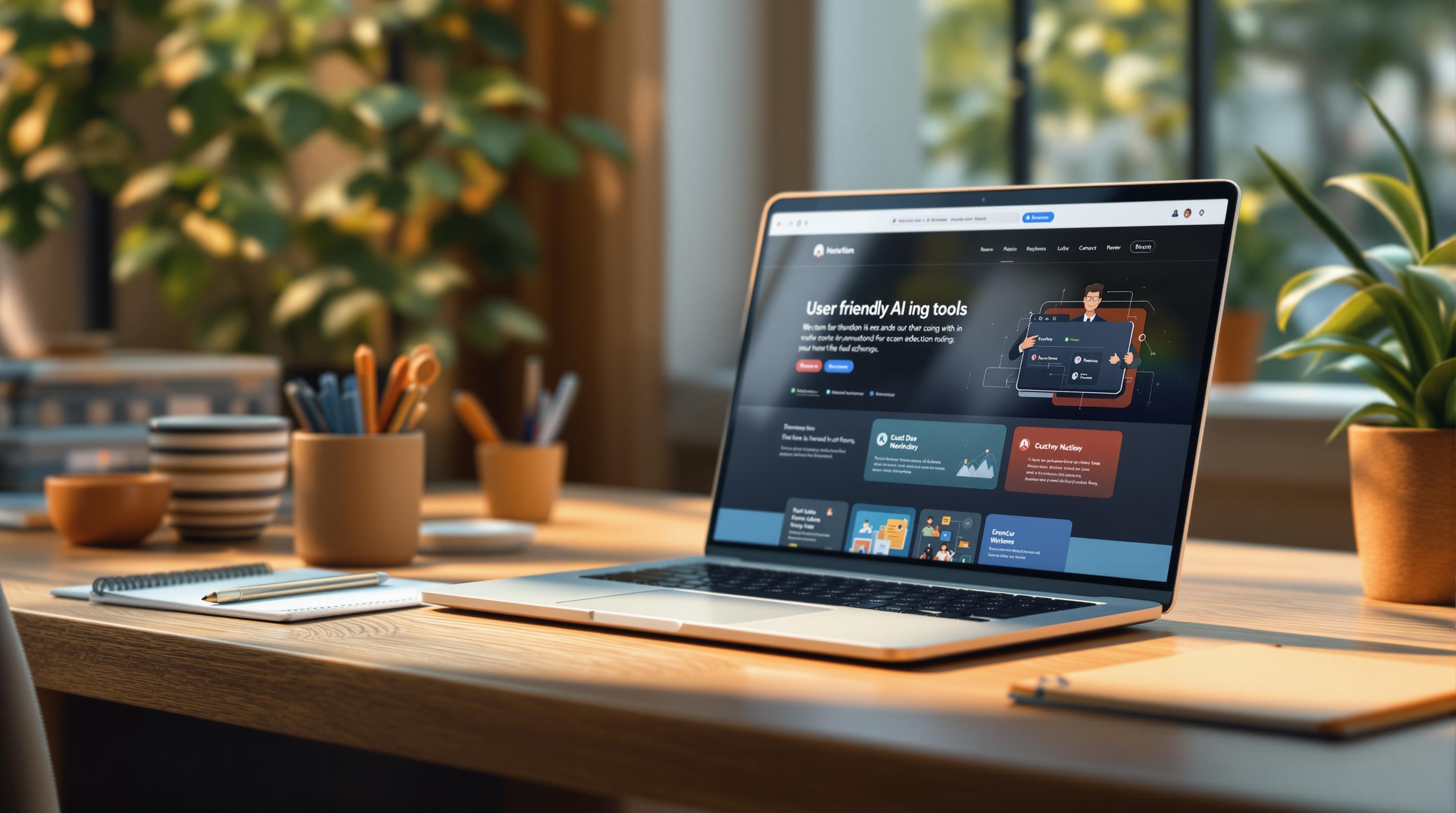Want to add an AI chatbot to your website without writing a single line of code? No-code platforms make it easy with drag-and-drop tools. Here's what you need to know:
- Benefits: 24/7 support, automated responses, better engagement, lead generation, and cost savings.
- Top Platforms: Botsonic, Sendbird, Wrapifai, Chatbase - each tailored for different needs.
- Setup Steps:
- Name your chatbot and customize its look.
- Upload FAQs or content for training.
- Embed it on your website with simple integration tools.
- Key Features to Look For: Integration options, customization, performance tracking, and security compliance.
With no coding required, you can enhance your website’s user experience and streamline customer interactions in minutes. Ready to get started? Let’s dive in!
How to Choose a No-Code AI Chatbot Platform
Popular No-Code Chatbot Platforms
These platforms allow you to add AI chatbots to your website without needing technical skills. Here are some of the top options:
| Platform | Key Strengths | Best For |
|---|---|---|
| Botsonic | Advanced AI for complex needs | Content-heavy websites |
| Sendbird | Enterprise-level security | Large-scale operations |
| Wrapifai | Focus on SEO and lead generation | Marketing-focused sites |
| Chatbase | Easy to use, quick setup | Small businesses |
Once you've shortlisted platforms, dive deeper into their features to make sure they align with your requirements.
Features to Look for in a Platform
When choosing a no-code chatbot platform, keep an eye on these key features:
Integration Capabilities
- Check if the platform connects seamlessly with your existing tools and messaging apps.
- Look for compatibility with CRM systems and knowledge bases [5].
Customization Options
- Visual tools for designing chatbot workflows.
- The ability to train the AI on your specific content [2].
Performance Tracking
- Monitor engagement, lead generation, and conversion metrics [5].
Security and Scalability
- Ensure the platform meets security standards like GDPR and HIPAA compliance.
- It should handle high message volumes efficiently and maintain fast response times [3].
"The key to successful chatbot implementation lies in selecting a platform that aligns with your business goals and offers the necessary features for effective website integration. Platforms with GPT-4 powered chatbots can significantly enhance customer engagement and lead generation." [2]
Steps to Add an AI Chatbot to Your Website
How to Set Up Your Chatbot
You don’t need to be a tech expert to set up an AI chatbot these days. Thanks to no-code platforms, the process is straightforward. Here's how you can get started:
Initial Setup
- Give your chatbot a name and choose an avatar to make it feel approachable.
- Create a friendly welcome message to greet visitors.
- Set business hours and configure automated responses for when you're offline.
- Define triggers that start conversations based on user actions.
Building the Knowledge Base
- Upload key resources like FAQs, product details, and company policies.
- Use AI tools to organize and structure this data for accurate answers.
- Add default replies for questions the chatbot can’t handle yet.
Customizing the Chatbot's Appearance
Most platforms let you tweak the chatbot's look using visual editors. Adjust the widget’s position, colors, fonts, and icons to match your website’s design. This helps maintain a cohesive brand feel and keeps users engaged.
Embedding the Chatbot on Your Website
Once everything looks good, it’s time to add the chatbot to your site. Here’s how:
- Go to your platform's integration section and grab your unique embed code.
- Add the chatbot to your website using one of these methods:
- Website builder widgets
- Directly placing the code in your site
- Using a tag manager
- Test the chatbot on different devices and browsers to make sure it works smoothly.
"The key to successful chatbot implementation lies in selecting a platform that aligns with your business goals and offers the necessary features for effective website integration. Platforms with GPT-4 powered chatbots can significantly enhance customer engagement and lead generation." [2]
No code Easy Webchat widget - AI Chatbot for your Website
sbb-itb-c495ab1
Tips for Personalizing and Launching Your Chatbot
After embedding your chatbot on your site, the next step is to make sure it connects with users through smart customization and a smooth launch process.
How to Customize Effectively
To make your chatbot feel like part of your brand, its personality and tone should match your business identity. For instance, a retail chatbot might be friendly and casual, while one for professional services should maintain a formal tone.
Here are some areas to focus on:
- Conversation Design: Build clear flows that guide users to what they need - whether it's FAQs, purchases, or support tickets.
- Response Efficiency: Make sure users can reach their goals quickly, with as few steps as possible.
- Brand Consistency: Keep the chatbot's tone and style in line with your company’s communication standards.
Testing and Launch Checklist
A bad experience can drive users away - 73% of users abandon chatbots after poor interactions [4]. Testing thoroughly before launch is non-negotiable. Use this table to guide your process:
| Testing Area | Key Actions | Success Criteria |
|---|---|---|
| Functionality | Check for accurate, fast responses | Replies in 2-3 seconds |
| User Experience | Test conversation paths | Smooth and logical interactions |
| Integration | Verify compatibility across devices | Consistent performance everywhere |
| Security | Review data handling practices | Compliance with GDPR/CCPA |
Key Steps for Launch Success:
-
Pre-launch Testing
- Test all conversation paths to ensure they work as planned.
- Evaluate the effectiveness of your welcome message.
- Simulate common user scenarios to check for proper handling.
-
Monitor Performance
- Keep an eye on metrics like user engagement, resolution success rates, average response times, and conversions.
-
Ongoing Updates
- Analyze user interactions to spot areas for improvement.
- Adjust responses to address frequent questions.
- Streamline conversation flows to make them even more efficient.
Research shows that well-executed chatbots can cut customer service inquiries by up to 70% [1].
Conclusion
Key Takeaways
No-code platforms have made AI chatbots accessible for businesses of all sizes. These tools provide drag-and-drop builders, customizable templates, and easy integrations to boost website engagement. A well-built chatbot can improve customer service by offering 24/7 support while staying aligned with your brand’s voice [1].
Tools to Get Started
Ready to add a chatbot to your website? Here are some platforms to consider, tailored to different needs:
- Botsonic: User-friendly interface with pre-built conversation components.
- Landbot.io: Offers a wide range of customization options and a rich template library.
- Chatbase: Combines advanced AI features with straightforward integration.
For businesses needing enterprise-grade security, platforms like Sendbird are worth exploring [3]. Whichever platform you choose, prioritize security and regularly analyze user interactions to keep your chatbot performing at its best [1][2].
FAQs
How do I create a chatbot for my website for free?
You can use no-code platforms with free plans to build an AI chatbot without any programming skills. Here's a simple guide to get started:
- Pick a Platform: Choose a no-code platform that offers free tools and a visual builder interface [1].
-
Set Up Your Chatbot:
- Write a friendly welcome message.
- Map out basic conversation flows.
- Add response buttons for quick replies.
- Enable features like email collection for lead generation [2].
- Match Your Branding: Customize the chatbot's colors, fonts, and avatar to align with your website's design for a polished look [5].
- Test and Launch: Check the chatbot's responses, test its functionality, ensure it collects data correctly, and confirm it works well on mobile devices before making it live [2].
Most free plans include basic templates and visual builders but come with limitations like restricted monthly messages and fewer customization options. If your needs expand, upgrading to a paid plan will unlock more features and higher capacity [1].
Common Free Plan Limitations:
- Message limits (usually 100–500 per month).
- Basic analytics only.
- Limited design and feature customization.
- Deployment restricted to one chatbot [2].
For more advanced tools or larger message volumes, consider scalable solutions like CometChat [1]. You can also revisit the platforms mentioned earlier in this guide to find one that fits your growing requirements.
"No-code platforms simplify chatbot creation, enabling quick deployment and 24/7 support without technical expertise."


